Predict the products, including stereochemistry where appropriate, for the m-chloroperoxybenzoic acid epoxidations of the following alkenes.
c. cis-cyclodecene
d. trans-cyclodecene

 Verified step by step guidance
Verified step by step guidance Verified video answer for a similar problem:
Verified video answer for a similar problem:



 2:19m
2:19mMaster General properties of epoxidation. with a bite sized video explanation from Johnny
Start learning